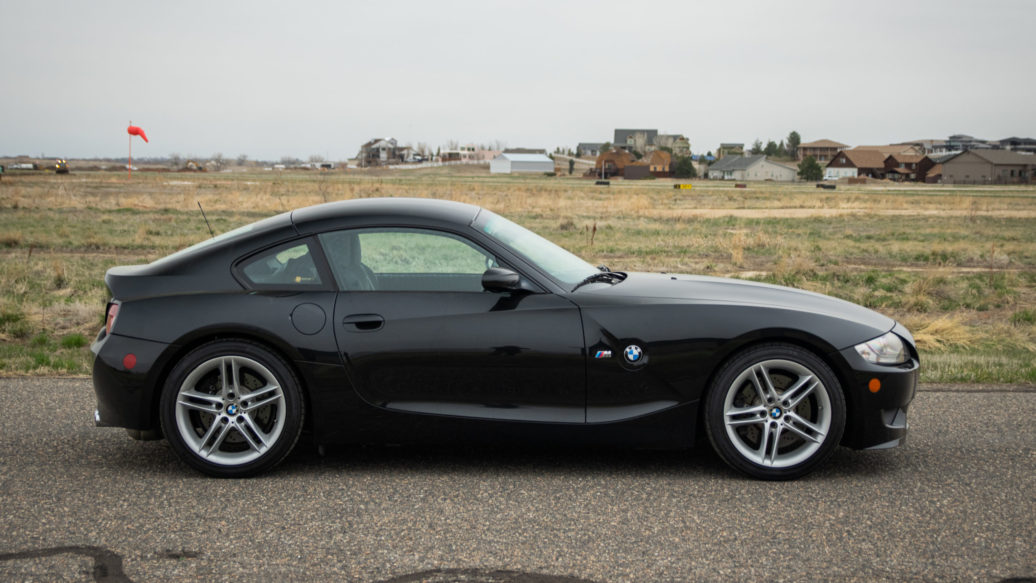Sometimes the best way to fully understand a car is to compare and contrast it with another; a proper comparison will reveal a car’s assets and its defects, and allow perspective that you just don’t get from a singular experience. My latest comparison, however, was rather unintentional, being more of a journey—physical and literal—with stops in vastly different places and cars along the way.
It all started in Jackson Hole, Wyoming, with a 1980 Alpina B7 Turbo Coupe.

The Alpina B7 Turbo Coupe.
By the late 1970s, Alpina was well established on its course from constructing typewriters to making BMWs into some of the fastest cars on the Autobahn. With the early B7 Turbo Coupe, Alpina tuned the E24 6 Series—the shark—into a 300-horsepower monster that rivaled the Porsche 911 Turbo. But because it was a BMW, it was gentleman’s monster, with grand-touring capabilities on par with the most civilized cars of the day.
The B7 Turbo Coupe found its way into my life when we picked it up in Jackson Hole and trailered it to Colorado. Once it arrived, we spent the next two years getting the fuel-injection system sorted with some very rare and specific Alpina parts. When it was all done, it was one of the most memorable cars I’ve ever driven.

Euro bumpers are a must for any E24.

Blue-and-green cloth and leather seats, along with extra gauges and a wooden shift knob, distinguish the Alpina from a regular E24.
Polaris Silver painted the turbo Shark’s elegant lines in the way that only silver does, and it was accentuated by chrome European bumpers and Alpina turbo-fanwheels. Inside, the blue-and-green cloth and leather interior was quintessentially classic Alpina, with enough extra gauges in the dashboard to make even an old-school pilot blush. And when it comes to driving? Shift the dogleg Getrag G265 five-speed gearbox into first, roll onto the throttle, and wait for the turbo to hit. Nothing happens at first, aside from the big-six M30’s buttery-smooth low-end torque, but that is the calm before the storm. Wait for it, wait for it—then, when the turbo hits, it’s not so much a slap across the face as a building crescendo, kind of like wading into the ocean and getting hit by a wave that’s a lot bigger than you initially thought.
The Alpina B7 Turbo Coupe was one of the fastest cars in the world when it was released in 1980, and it remains addictively fast—even in the modern world.
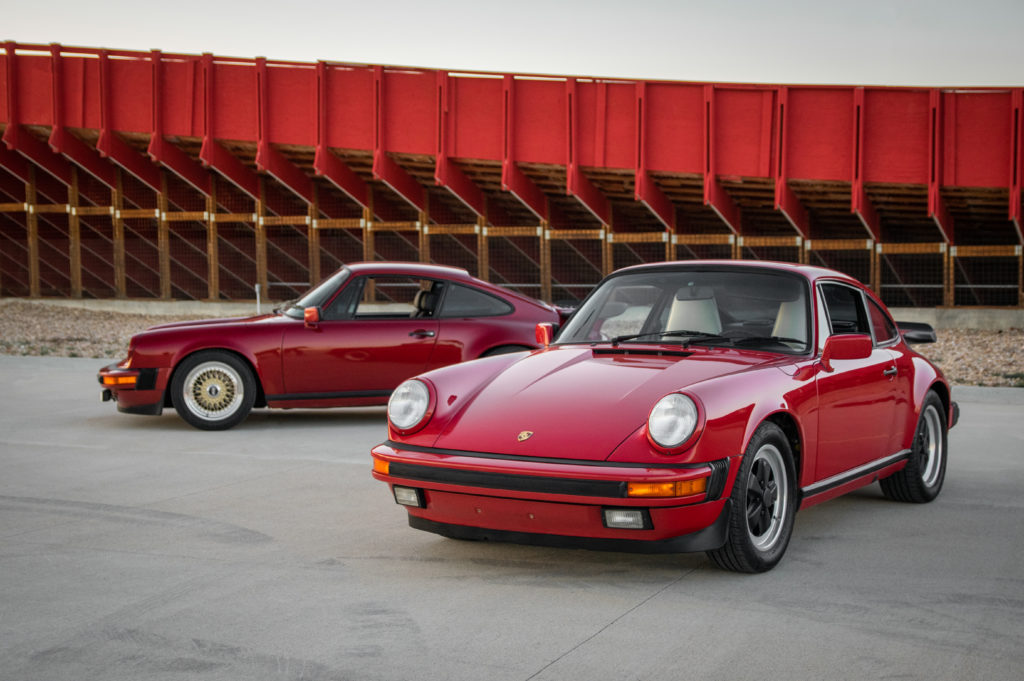
The Porsche 911 Carrera 3.2 poses with the 911SC in the background.
We eventually sold the Alpina B7 Turbo Coupe, and when we did, the previous owner was interested in a 1987 Porsche 911 Carrera that I happened to have. The G-body Porsche 911 reigned from 1974 to 1989 in various forms, but aside from their easily identifiable square impact bumpers, they all shared the kill-you-if-you-lift torsion-bar suspension. In 1984, the Carrera followed the Super Carrera (abbreviated 911SC), which in typical less-is-more Porsche fashion, was so super that it no longer needed to be called super.
The 1984 through 1989 Carrera was distinguished by a 207-horsepower 3.2-liter engine, earning it the Carrera 3.2 moniker. Starting in 1987, the Carrera 3.2 received the Getrag G50 gearbox. This is significant because the G50 gearbox had none of the John Deere-tractor-like shifting tendencies of the earlier G-body 911’s 915 gearbox. As a result, the 1987 to 1989 G50 911s are considered the pinnacle of the air-cooled G-body 911s. Several years ago, I broke a nearly two-decade streak of E30 ownership to buy my G-body 911SC (pictured in the background above).

Carmine Red was a rare color for a G-body 911.

The 911 interior is simple and uncluttered, while the light Linen leather adds airiness.
Our Carrera 3.2 was finished in Carmine Red with a white (Linen, in Porsche speak) leather interior. Carmine Red was rare color on a G-body, and that—along with the whale tail (technically, it’s a 3.2 tail)—is the defining elements of the car. The Carrera 3.2 has more low-end torque than my 911SC and the BMW E30, with better steering and even more connection to the road than the already telepathic BMW. It sacrifices the E30’s sport-sedan civilities, but the undiluted sports-car experience is worth the trade-off.
There is just something special about driving an air-cooled 911. As you look out down the hood, the raised fenders frame your visual canvas, with the road in between yours to paint. Want to visit the limit? You will have to work to do so, but as long as you don’t lift when you shouldn’t, there are few driving experiences as blissful as a Carrera 3.2. I do not share the opinion that the G50 gearbox is superior to the 915, either; the latter is certainly a harder gearbox to drive, but there is a certain satisfaction that comes from its mechanical Winchester bolt-action rifle-like gear engagement—when it doesn’t refuse your requests. That said, the Getrag G50 gearbox has none of the 915’s drama, and the rest of the Carrera 3.2 is proportionally fantastic.

The Carrera 3.2 arrives in Florida…
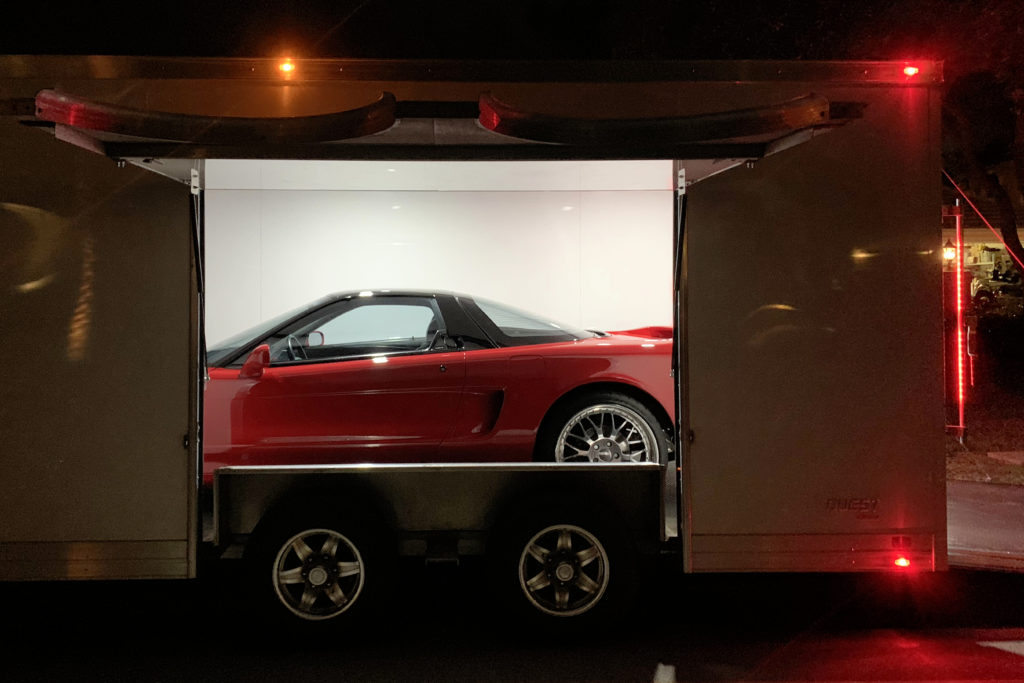
…and an Acura NSX goes in the trailer.
I offered to deliver the Carrera 3.2 to the new owner’s beach house in Florida, which would afford me the opportunity to pick up another car I had on my radar: a 1994 Acura NSX. The NSX was born in an age when Honda engines powered Formula 1 cars and its drivers won Formula 1 championships. Honda enlisted those F1 drivers to develop and fine-tune its new supercar—most notably a certain Brazilian by the name of Senna. A dedicated team assembled the NSX in its own production facility, and it boasted technology never before seen in a street production car, including all-aluminum monocoque construction that was incredibly rigid and lightweight.
The first-generation (NA1) NSX was powered by a mid-mounted three-liter aluminum V6 featuring forged pistons and titanium connecting rods that allowed a redline well north of 8,000 rpm. Compared to the Carrera 3.2, the NSX has roughly 70 more horsepower (270 in the NA1 NSX) with approximately 200 cc less displacement—not too shabby for Honda!

Formula Red suits the Acura NSX perfectly.
Red is to the NSX color pallette as silver is to BMW’s, and this one looked amazing finished in Formula Red over a black interior. 1994 was the last year of the coupe body, and is also significant because it was clear of the transmission snap-ring issues that plagued some early-model-year NSXs. This example’s only modifications were aftermarket wheels and a Tubi exhaust. Inside, low is the theme: You are virtually sitting on the floor with one of the most driver-centric and cockpit-like interiors ever put in an automobile surrounding you.
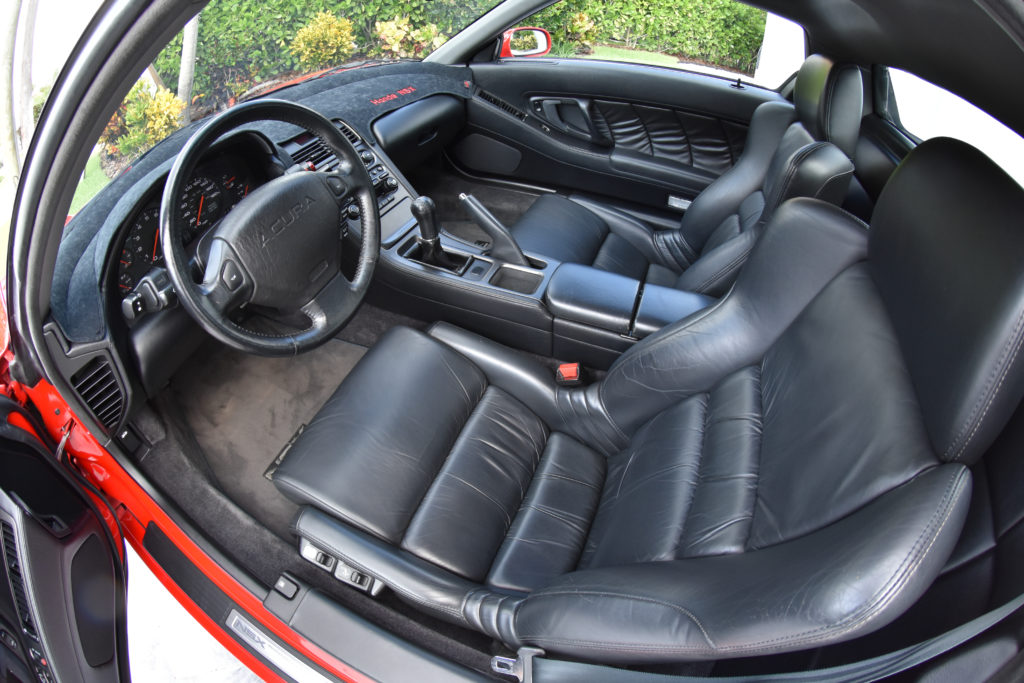
A fisheye is the only way to capture all of the NSX’s cockpit.
Once under way, in every way that the Carrera 3.2 is delightfully visceral, the NSX is better. You can feel the fanaticism that those Honda engineers painstakingly poured into developing the NSX, followed by Ayrton Senna himself, who played a significant role in the chassis rigidity and the suspension tuning. The engine screams to its 8,000 redline (in this example, the sound comes thanks to the Tubi exhaust), but it requires you to send the tach needle north to develop its power. The early NA1 NSX five-speed gearing is tall: redline in second gear is over 80 miles per hour, and you can literally do all of the street driving you’d ever need to without shifting past that gear. But that would be tragic, because then you wouldn’t experience how incredibly precise that shifter is. Transformer-like inwardly angled fenders and old-school pop-up headlights frame the view out of the raked windshield, and you are much lower to the ground than in the 911. There is no power steering, but even with fat front tires, the NSX is perfectly weighted at all but parking lot speeds.

The NSX is low—very low!
The NSX was and is often misunderstood because of its lack of raw horsepower compared to the supercars it was designed to compete with, but that was never the NSX’s mission. The NSX was and remains a tool of incredible precision; if you drive it, you have to turn your gain up to truly appreciate the nuance of. Senna could find seconds where others could only find tenths, and that legacy is felt from behind the wheel of the NSX.
Once you do turn up that gain, exponential performance can be extracted from a car that is unflinchingly willing to do your bidding. Take away the leather seats and air conditioning, and it feels like an F1 car, offering a connection between human and machine that is lost on most cars of today—and most cars of the NSX’s day. In fact, it was so good that Gordon Murray used the NSX as his baseline for developing the McLaren F1.
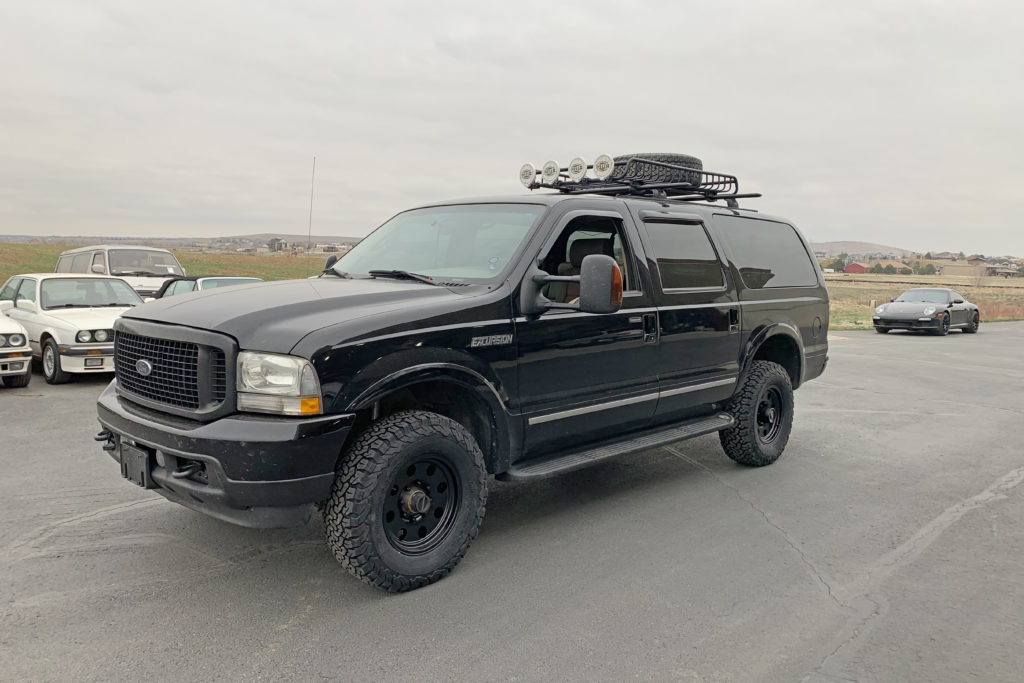
The new tow rig, a 2004 Ford Excursion with the 6.0 Power Stroke diesel.
In January, I wrote about my tow rig dilemma, which I solved with a diesel Ford Excursion. The Excursion had been serving me well until it did what Fords like to do (FORD: Found On Road Dead) and broke down in Georgia on my way to deliver the Carrera 3.2. Needing to complete the mission, I rented a truck to drop off the Carrera 3.2 and pick up the NSX. Then I stayed at a friend’s house in Atlanta for a few days waiting for the Excursion to be repaired. It turned out to be an expensive visit, since he took a liking to the NSX. When I finally left, it was with his former BMW Z4 M coupe in the trailer and the NSX parked in its new home next to his BMW X5 M.

The NSX joins the X5 M in the garage and the Z4 M coupe goes on the trailer.
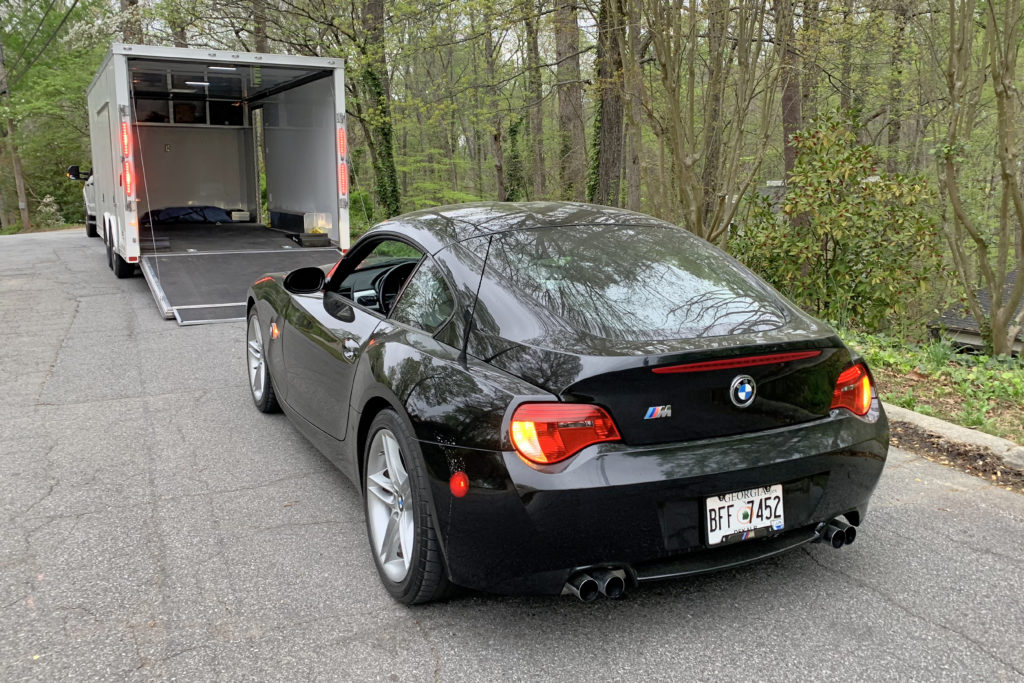
The Z4 M coupe is another decade forward in the evolutionary arc on our journey, but it is significant, because the Z4 M coupe is one of the last BMWs with the old-school sports-car recipe: a powerful high-revving naturally-aspirated engine, a simple and focused interior, a manual gearbox, and rear-wheel drive.

The Z4 M coupe is a modern old-school sports car.
This is also a great time to buy a Z4 M coupe, since it has not experienced the recent appreciation of the Z3 M cars or the E46 M3—but it is no worse for that, either. The Z4 M coupe was the last application of BMW’s legendary S54 engine; it had none of the Z3 M’s bad suspension manners, and it was fitted with the E46 M3 Competition Package brakes as standard kit. To some, its Bangle-era flame-surface design isn’t as elegant as the Z3 M’s flowing lines—well, the roadster, anyway—but in coupe form, it isn’t as polarizing as the Z3’s clown-shoe shooting-brake rear end.
Inside, the interior is focused and uncluttered. I wouldn’t call the cockpit driver-centric, but it makes up for that by bridging the gap between BMWs of the past with contemporary switchgear and a fantastic steering wheel.
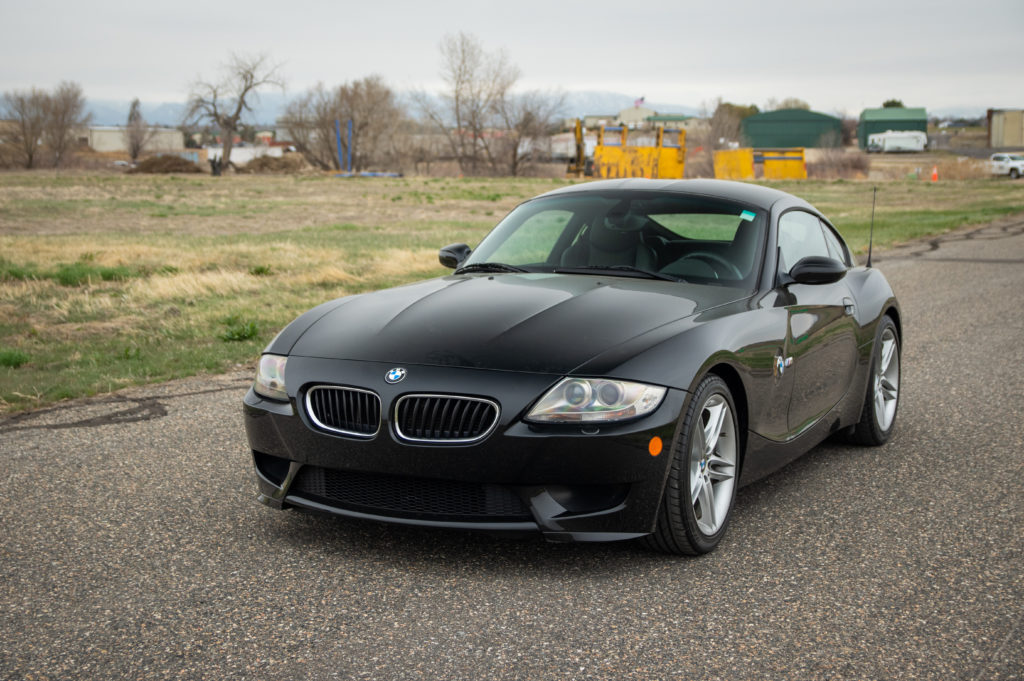
The Z4 M has Chris Bangle-era flame surfacing and a lovely flow in coupe form.
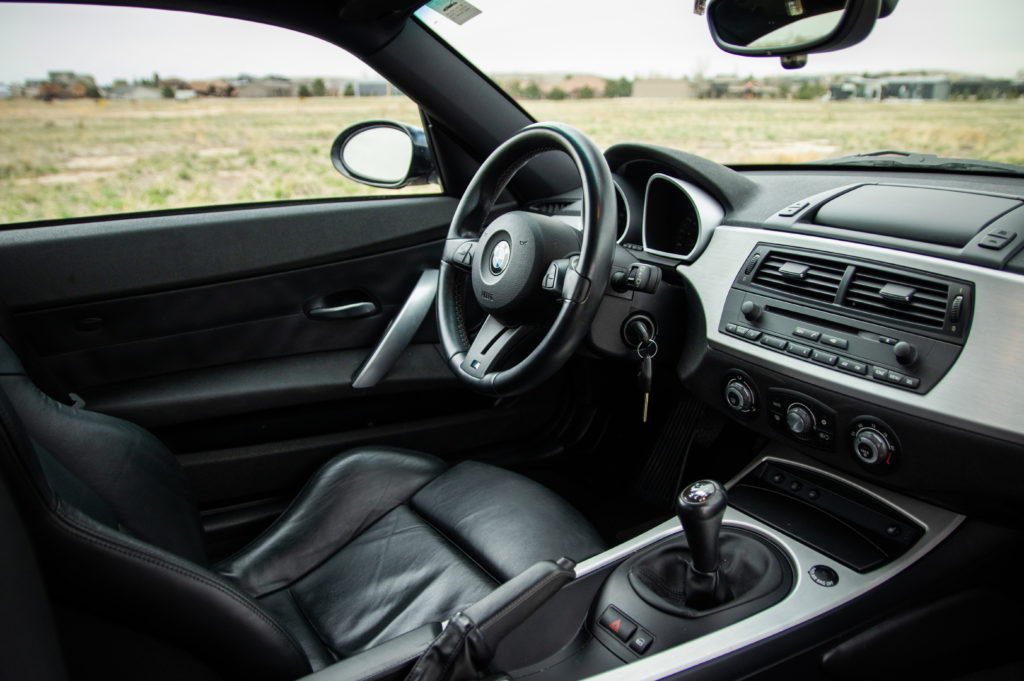
The cockpit is tight and the steering wheel is superb.
When you sit down, you strap this car on every bit as much as the NSX, with the forward view over that long nose framed by flame-surfaced cut lines in the hood. Visibility in the rear three-quarter angles is non-existent, but you won’t be in need of that, since the Z4 M coupe is significantly faster than anything else on our journey—stiffer, too. Roll into the throttle and the S54 screams to its 8,000-rpm redline with more razor-edged ferocity than either the Z3 M or the E46 M3 does. Take the Z4 M coupe to the limit, and the experience is brutish, with grip and stopping power that will make your passengers scream, and a chassis that is notably more neutral than most stock BMW M cars.
However, you will need to mind the rear end every bit as much as you do with the air-cooled 911. The Z4 M coupe will snap much faster if you don’t, but once you get dialed in to it, power-on oversteer fosters insatiable adolescence at every opportunity. The Z4 M coupe marked the end of an era for high-revving, naturally aspirated inline six-cylinder BMWs, and a good example may be found for half the price of the $60,000-plus budget required for the other examples on our journey.
I lost a week getting the Ford Excursion fixed, but I wouldn’t call it unproductive. I had no clue that I’d end up with a Z4 M coupe coming home in the trailer, but I’m glad we kept the NSX in our extended family. Who knows what the next adventure will bring? But as in this fateful journey, sometimes it truly does take one car to fully appreciate another.—Alex McCulloch
[Photos courtesy of Peter Thompson.]

